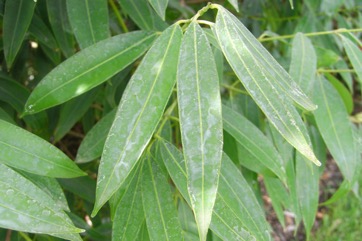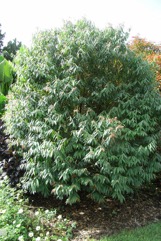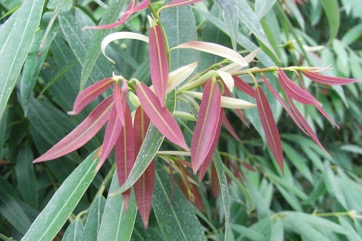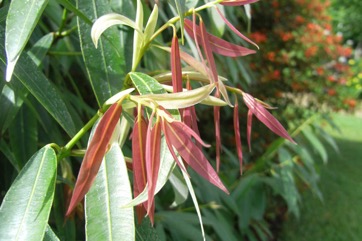Indian rose chestnut

A tropical plant. It is native to Asia. It grows between 500-600 m altitude in China. In India it grows from 60-1200 m altitude. It grows in evergreen humid forest. It can grow in bright shade or full sun. It does best in rich, slightly acid soil. In XTBG Yunnan. It suits hardiness zones 11-12.
Also known as:
Bosneak, Bun nak, Bun-naak, Changkok, Dieng-ngai, Gangane, Gangaw, Ironwood, Irul, Ka thang, Kawtanok, Kesaramu, Lenggapus, Mai-kam-kaw, Mai-ting, Matopus, May lek, Mentepus, Mesua, Na, Nag champa, Naga sari, Nagacesara, Nagachambagam, Nagachampakamu, Nagakeshara, Nagasampige, Nagasari, Nagchampa, Nagesar, Nageswar, Nagkesar, Nagkesara, Nahor, Nak but, Nanga, Nangal, Nangu, Ngai-ching, Penaga lilin, Penaga puteh, Penaga sabut, Penaga suga, Penaga, Penga kunyit, Peri, Poached egg tree, Pohon nagasari, Tapis, Vap, Veluthapala
Synonyms
- Calophyllum nagassarium N. L. Burman
- Mesua nagana Gardner
- Mesua nagassarium (N. L. Burman) Kostermans
Edible Portion
- Seeds, Fruit, Leaves
Where does Indian rose chestnut grow?
Found in: Andamans, Asia, Australia, Bangladesh, Cambodia, China, Fiji, Himalayas, India, Indochina, Indonesia, Laos, Malaysia, Myanmar, North America, Northeastern India, Pacific, Papua New Guinea, PNG, SE Asia, Singapore, Sri Lanka, Thailand, United States, Vietnam
Notes: The seeds yield an inedible oil used in industry. There are about 3-5 Mesua species.
Status: A cultivated tree.
Growing Indian rose chestnut
Cultivation: It can be grown from fresh seed or cuttings using mist. Half hardened cuttings should be used. Fresh seed germinate in about 10-14 days. Seed are best to be soaked before sowing. Seedlings can be transplanted when 2-3 years old.
Edible Uses: The young leaves can be eaten raw. The oily seeds need to be well cooked and then are eaten. The fruit is used as an addition to some dishes.
Production: It is slow growing.
Nutrition Info
per 100g edible portion| Edible Part | Energy (kcal) | Protein (g) | Iron (mg) | Vitamin A (ug) | Vitamin c (mg) | Zinc (mg) | % Water |
|---|---|---|---|---|---|---|---|
| - | - | - | - | - | - |
Indian rose chestnut Photos




References
Ambasta, S.P. (Ed.), 2000, The Useful Plants of India. CSIR India. p 368
Angami, A., et al, 2006, Status and potential of wild edible plants of Arunachal Pradesh. Indian Journal of Traditional Knowledge 5(4) October 2006, pp 541-550
Barwick, M., 2004, Tropical and Subtropical Trees. A Worldwide Encyclopedic Guide. Thames and Hudson p 273
Bremness, L., 1994, Herbs. Collins Eyewitness Handbooks. Harper Collins. p 65
Burkill, I.H., 1966, A Dictionary of the Economic Products of the Malay Peninsula. Ministry of Agriculture and Cooperatives, Kuala Lumpur, Malaysia. Vol 2 (I-Z) p 1482
Conn, B.J., (Ed.) 1995, Handbooks of the Flora of Papua New Guinea. Vol 3. Melbourne University Press. p 126
Cundall, P., (ed.), 2004, Gardening Australia: flora: the gardener's bible. ABC Books. p 891
Dey, A. & Mukhererjee, A., 2015, Living and Survival Amidst Hunger: Wild Edible Botanicals as a Prime Forest Productivity in the Rural Purulia District, West Bengal, India from Colonial to Present. Research Journal of Forestry 9(3): 71-86
Engel, D.H., & Phummai, S., 2000, A Field Guide to Tropical Plants of Asia. Timber Press. p 49
Etherington, K., & Imwold, D., (Eds), 2001, Botanica's Trees & Shrubs. The illustrated A-Z of over 8500 trees and shrubs. Random House, Australia. p 477
Facciola, S., 1998, Cornucopia 2: a Source Book of Edible Plants. Kampong Publications, p 79
Flora of China. Vol. 13 p 38
Gardner, S., et al, 2000, A Field Guide to Forest Trees of Northern Thailand, Kobfai Publishing Project. p 52
Hedrick, U.P., 1919, (Ed.), Sturtevant's edible plants of the world. p 413
Krishen P., 2006, Trees of Delhi, A Field Guide. DK Books. p 176
Li Xi-wen & Li Jie; Peter F. Stevens, Clusiaceae [Draft], Flora of China
Llamas, K.A., 2003, Tropical Flowering Plants. Timber Press. p 173
Martin, M.A., 1971, Introduction L'Ethnobotanique du Cambodge. Centre National de la Recherche Scientifique. Paris.
Menninger, E.A., 1977, Edible Nuts of the World. Horticultural Books. Florida p 47
Sahni, K.C., 2000, The Book of Indian Trees. Bombay Natural History Society. Oxford. p 27
Singh, H.B., Arora R.K.,1978, Wild edible Plants of India. Indian Council of Agricultural Research, New Delhi. p 66
Singh, V. B., et al, (Ed.) Horticulture for Sustainable Income and Environmental Protection. Vol. 1 p 217
Smith, A.C., 1981, Flora Vitiensis Nova, Lawaii, Kuai, Hawaii, Volume 2 p 339
Sp. pl. 1:515. 1753
Sukarya, D. G., (Ed.) 2013, 3,500 Plant Species of the Botanic Gardens of Indonesia. LIPI p 395
Swaminathan, M.S., and Kochnar, S.L., 2007, An Atlas of major Flowering Trees in India. Macmillan. p 297
Tanaka,
Van Sam, H. et al, 2004, Trees of Laos and Vietnam: A Field Guide to 100 Economically or Ecologically Important Species. Blumea 29 (2004) 201-349
Wickens, G.E., 1995, Edible Nuts. FAO Non-wood forest products. FAO, Rome. p 132
World Checklist of Useful Plant Species 2020. Royal Botanic Gardens, Kew
Yesodharan, K. & Sujana, K. A., 2007, Wild edible plants traditionally used by the tribes in the Parambokulam Wildlife Sanctuary, Kerala, India. Natural Product Radiance 6(1) pp 74-80